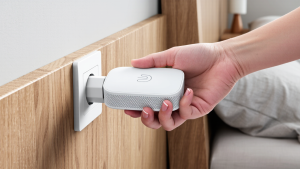Introduction
Learning how to effectively boost Wi-Fi signal performance is probably the single most important skill for a modern smart home. We have all been there: you are in the middle of a crucial Zoom call with your boss or watching the climax of a movie on Netflix, and suddenly, the screen freezes. It is incredibly frustrating, especially when you are paying good money for a high-speed internet plan.
Many people automatically assume their internet service provider (ISP) is to blame. They call customer service, complain, and get told everything looks fine on their end. As a tech enthusiast who has set up networks for dozens of friends and family members, I’ve learned that the problem usually lies within your own four walls. Wi-Fi is essentially just radio waves, and radio waves are easily blocked, absorbed, or interfered with. The good news is that you don’t always need to buy expensive new gear to fix it. Sometimes, a simple tweak is all it takes.
In this comprehensive guide, I will walk you through the practical steps I use to optimize home networks. Let’s get your internet flying again.
1. Position Your Router Correctly to Boost Wi-Fi Signal
I cannot stress this enough: location is everything. Most people have their router installed in the corner of the living room, near the cable jack, or worse—hidden inside a TV cabinet because “it looks ugly.”
Think of your router like a lightbulb. If you put a lightbulb in a closet and close the door, how much light will reach the rest of the house? Very little. Wi-Fi signals travel out in all directions, but they struggle to punch through thick obstacles like wood, glass, metal, and water (yes, fish tanks are Wi-Fi killers).

To instantly boost Wi-Fi signal strength without spending a penny, move your router to a central location in your home. If possible, place it high up on a shelf rather than on the floor. The floor is full of obstructions like furniture legs, and radio waves travel better downwards and outwards.
2. Switch to the 5GHz Frequency Band
If you have a modern “Dual-Band” router (most routers made in the last 5 years are), you actually have two different Wi-Fi networks broadcasting at the same time: 2.4GHz and 5GHz.
-
2.4GHz: This is the old standard. It travels through walls well but is slower and very crowded. Your microwave, baby monitor, and Bluetooth devices all fight for space here, causing interference.
-
5GHz: This is the fast lane. It doesn’t travel through thick walls as easily, but the data speeds are significantly faster.
If you are sitting relatively close to the router, make sure your phone or laptop is connected to the 5GHz network. It acts like a secret turbo button for your speed. You can usually tell the difference because the network name might end in “_5G”.
3. Update Your Router’s Firmware
When was the last time you logged into your router’s admin panel? If the answer is “never,” you might be missing out on critical performance updates.
Router manufacturers like Netgear and Asus frequently release software updates (called firmware) to fix bugs, patch security holes, and improve signal handling. Running on old software is like trying to run a marathon in heavy boots. Check your router’s manual or the sticker on the bottom to find the login address. It might seem technical, but it helps boost Wi-Fi signal stability significantly.
4. Use a Wi-Fi Extender or Mesh System
Sometimes, your house is just too big, or the walls are made of materials that kill Wi-Fi, like concrete or brick. In these cases, a single router simply isn’t enough to cover the whole area.
For a cheap fix, you can buy a Wi-Fi Extender. These plug into a wall outlet halfway between your router and the dead zone. They catch the signal and “repeat” it. They are okay for basic browsing, but they can cut your speed in half.

The better (but more expensive) solution is a Mesh Wi-Fi System. Unlike extenders, mesh nodes talk to each other to create a single, seamless blanket of fast internet. If you have a large home, investing in a Mesh system is the single best way to boost Wi-Fi signal coverage in every room.
5. Kick Off Unwanted Guests
Is your internet slow every evening at 7 PM? It might not be you. It might be your neighbors. If your Wi-Fi password is weak (or if you are still using the default one written on the sticker), someone else could be leeching off your bandwidth to stream 4K videos.
You can download a free app like “Fing” or log into your router to see a list of connected devices. If you see a “PC-USER” or “Unknown Device” that you don’t recognize, change your password immediately. This kicks everyone off, and you can reconnect only your own devices.
6. Adjust the Antennas Correctly
If your router looks like a robotic spider with multiple external antennas, don’t just point them all straight up. Wi-Fi signals broadcast perpendicular to the antenna.
-
If you need signal on the same floor, position the antennas vertically (pointing up).
-
If you need signal on multiple floors, position one antenna vertically and another horizontally (flat).

Conclusion
You don’t have to suffer through endless loading circles. By moving your router, switching to 5GHz, or investing in a Mesh system, you can drastically boost Wi-Fi signal performance throughout your home. Start with the free tips first—move that router out of the cabinet!—and see how much your speed improves.

